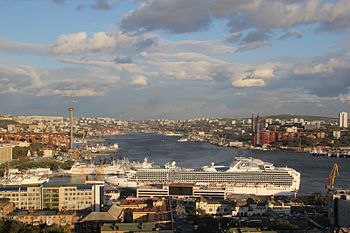 |
| @1: Sao Paolo |
Cities in Brazil are home to nearly 75% of Brazil's population. It wasn't long ago, perhaps less than 40 years ago, that most Brazilians called the rural areas of Brazil home.
The shift to urban life from rural life has presented several social challenges for the country of Brazil in both the larger and the smaller cities.
 |
| #2: Rio de Janeiro |
The influx of people coming into the cities from the rural areas of Brazil has caused the favelas, or slums, to grow at a rapid rate along with crime and poverty. The cities did not have the housing or jobs to absorb all of the people migrating into the city.
City governments in Brazil have attempted to deal with the favela communities in several ways, including the demolition of the favelas during the 1970s. When this didn't work, the governments finally began to recognize these people as part of the larger community and now provide services for them. Services might include sewage, electricity, and paved roads. Schools and health clinics have also been established.
There are increased numbers of homes in the cities, but still the poorer people do not have the means to purchase them, so it's very difficult for those coming into the city from the country to find a decent home.
Top 10 Cities in Brazil
1. Sao Paulo
This vibrant city is known for music, theatre, museums, car racing, sports, and incredibly varied ethnic cuisine. It's also home to 20+ landmarks important to the history of Brazil. Sao Paulo is Brazil's premiere business center. Nearly every industry of Brazil is represented in Sao Paulo, one of the busiest cities in Brazil.
Population - 10 to 11 million
Sao Paulo Fashion Week - largest fashion show in Latin America held annually
Home to over 15 universities and colleges
2 major train stations and 2 airports
Has the highest number of regularly operating helicopters in the world
2. Rio de Janeiro
Rio is perhaps best known for its amazing beaches, such as Copacabana, Leblon, and Ipanema, but Rio has so much more to offer. This city is also famous for stunningly beautiful scenery and carnivals.
Population - over 5 million
Christ the Redeemer statue
Maracana Stadium - one of the largest football stadiums in the world
Sugarloaf Mountain
Hosting 2016 Olympics
Tourism is Rio de Janeiro's primary industry
3. Salvador
Salvador has been dubbed Brazil's capital of happiness. This city is a mix of rich historical heritage and modern life.
Population - just over 2 million
Noted for - music, food, arts, and architecture
Industries - petrochemical plant, oil refinery, and tourism
Salvador is one of Brazil's most important ports and trade centers
Host to the largest street party in the world - Carnaval of Salvador da Bahia
4. Brasilia
This is one of the most unique cities in Brazil as it is actually not really a city at all! Brasilia is an administrative district of the Federal District of Brazil.
Brasilia is one of the few planned communities that exist in the world. It was built in just four years and appears from the sky in the shape of an airplane!
All branches of the Brazilian government are located here, as well as many major companies and industries.
Population - 2.6 million
Capital of Brazil
Brasilia International Airport
Important government and economic hub of Brazil
Industry - construction, recycling, furniture, pharmaceuticals, food processing
Historic sites and museums
5. Belo Horizonte
Population - 2.4 million
Largest city of Minas Gerais
Industry - agriculture, mining, automobiles, textiles, biotechnology, steel, gold and gems
Music, theatre, dance, food, and museums
Several cultural landmarks
6. Fortaleza
Population - 2.5 million
Nightlife, carnivals, comedians, cuisine, music festivals
Industry - tourism and national and international commerce
8 historic landmarks
16 miles of urban beaches
7. Curitiba
Population - 1.8 million
Capital of Parana
2nd largest manufacturer of automobiles in Brazil
Industry - commerce, finance, and services
Ecological capital of Brazil - 28 parks and many wooded areas
8. Manaus
Population - 1.7 million
Capital of Amazonas
Surrounded by the Amazon jungle
Home to largest neighborhood in Latin America - New Town
Industries - petroleum refining, Brazil nuts, timber and the manufacture of motorcycles, soap, ships, chemicals, and beer
9. Recife
Population - 1.5 million
Capital of Pernambuco
2 international ports
Guararapes International Airport
Home to over 50 bridges in city proper
Most prominent and important commercial center of North Brazil
2nd largest medical center in Brazil
Industries - electronics for automobiles, canning, textiles, brewing, manufacturing of tubes, and chocolate
Carnivals, shopping centers, museums, and home to musicians, writers, and dancers
10. Belem
Population - 1.4 million
Capital of Para
Serves as entrance to the Amazon - home to an airport, bus station, and port
Known as the City of Mango Trees because there are so many mango trees throughout the city
14 freshwater beaches
Hosts the most important religious celebration in Brazil - Cirio of Nazare
Belem International Airport - largest airport in North Brazil
Industries - international cargo, warehouses along miles of wharf to handle incoming and outgoing cargo
Learn more: http://www.celebratebrazil.com/cities-in-brazil.html#ixzz1PE81ydtO


















